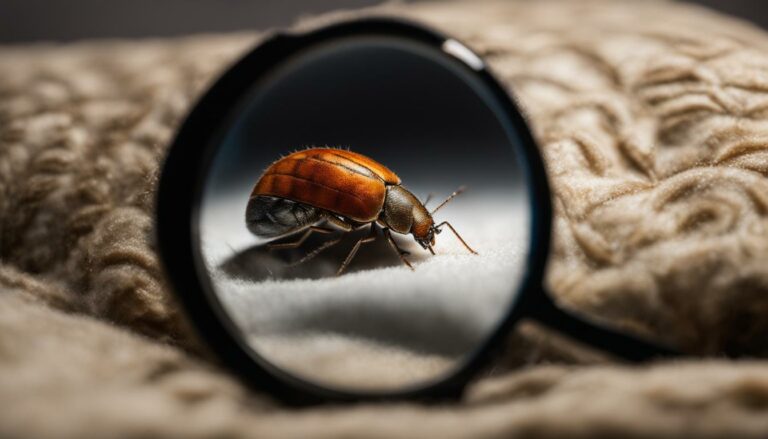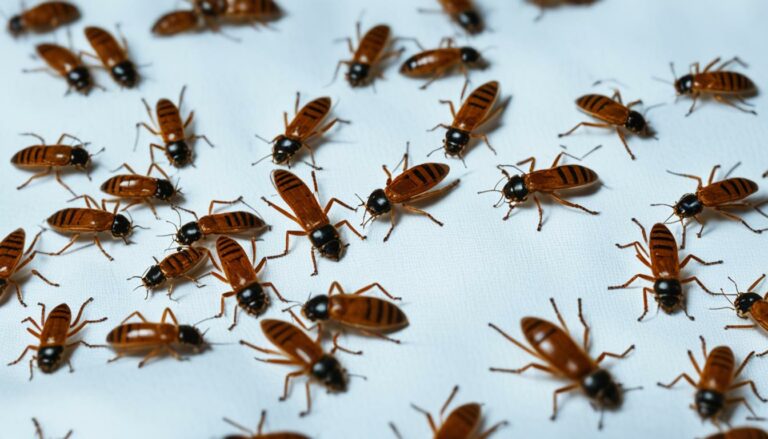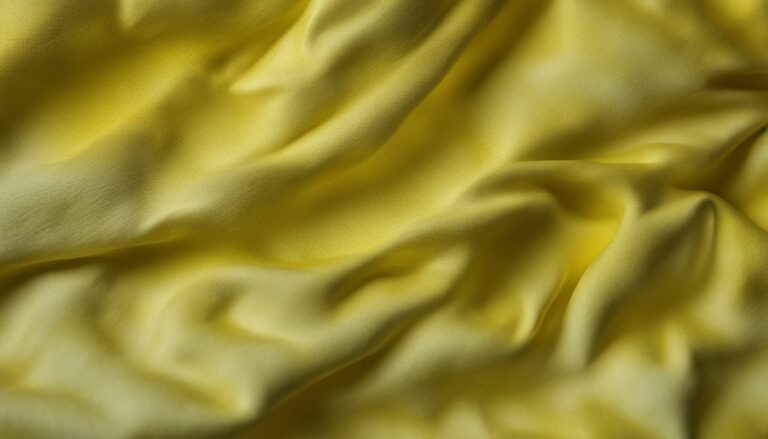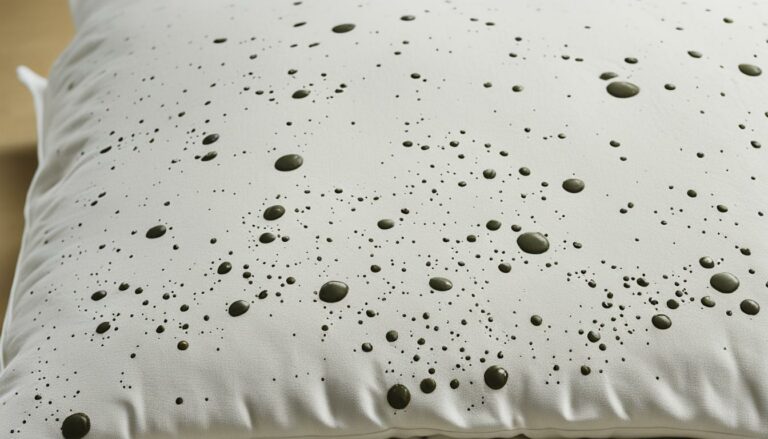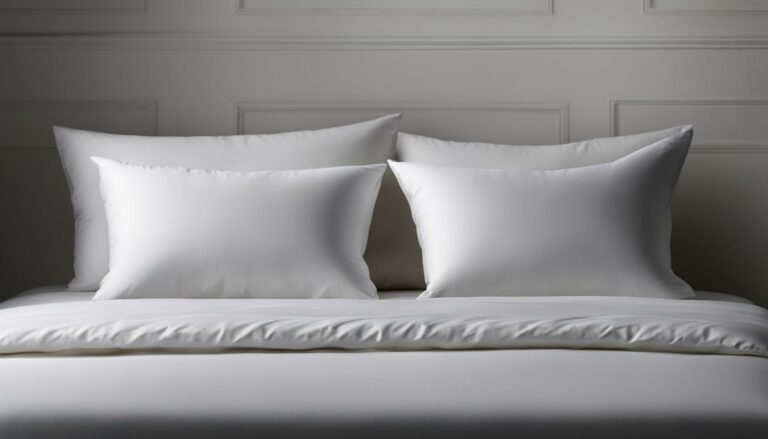Are Yellow Pillows Bad? Risks & Solutions Unveiled.
Eric Christie stands as a luminary in the bedding industry, with a career spanning nearly four decades since the early 1980s. His journey through the world of bedding has seen him wear many hats – a manufacturer, designer, and retailer, showcasing his versatility and expertise in Read more...
pillowsandbedsheets.com and its partners may earn a commission if you purchase a product through one of our links
Have you ever wondered if those old yellow pillows are really bad for your health and skin? As it turns out, they may pose more risks than you think. Dermatologist Dr. Zubritsky recently revealed on TikTok that sleeping on yellow pillows can have detrimental effects on your well-being. The yellow stains on these pillows are a result of dirt, grime, and moisture accumulation, which can lead to various skin problems, respiratory issues, and even sleep disturbances.
Yellow pillows not only harbor dust mites – a common trigger for allergies and asthma – but they can also become a breeding ground for mold. These factors contribute to poor sleep hygiene and can seriously impact your overall health and well-being. So, it’s time to take a closer look at the dangers of sleeping on yellow pillows and explore solutions to mitigate these risks.
Key Takeaways:
- Sleeping on yellow pillows can lead to skin problems, respiratory issues, and sleep disturbances.
- Yellow stains on pillows are caused by dirt, grime, and moisture accumulation.
- Dust mites and mold thrive in yellow pillows, triggering allergies and compromising sleep hygiene.
- Prioritizing hygiene and cleanliness over pillow color is crucial for maintaining good sleep health.
- Regularly washing pillowcases and using pillow protectors can help prevent yellow stains.
The Dangers of Sleeping on Yellow Pillows
Yellow stains on pillows can indicate a buildup of sweat, natural body oils, drool, wet hair, hair products, cosmetics, and oil-based serums and moisturizers. These unsightly stains not only affect the appearance of your pillows but also pose risks to your skin health and overall well-being.
One of the main concerns with sleeping on yellow pillows is the potential for clogged pores, breakouts, acne, and skin irritations. The moisture and dirt trapped in these pillows create an ideal environment for bacteria to thrive, which can exacerbate conditions like atopic dermatitis, eczema, and rosacea.
Furthermore, yellow pillows can be a breeding ground for dust mites. These microscopic pests feed on dead skin cells and can trigger respiratory issues and allergies. The allergens produced by dust mites can cause sneezing, itching, congestion, and even asthma attacks in susceptible individuals.
Mold growth is another significant concern associated with yellowing pillows. Moisture trapped in the pillow can create a favorable environment for mold spores to proliferate. Breathing in mold spores can lead to respiratory problems and worsen existing allergies or asthma symptoms.
“Sleeping on yellow pillows not only affects the appearance of your bedding but also poses risks to your skin health and overall well-being.”
To ensure better sleep hygiene and minimize these risks, it is essential to address yellow pillow stains and maintain proper pillow hygiene.
The Importance of Pillow Hygiene
Proper pillow hygiene is crucial for maintaining a clean sleep environment and preventing the accumulation of dirt, grime, and stains. Regular cleaning and care can help eliminate allergens, prevent skin issues, and promote better overall health.
Reducing Risks of Yellow Pillows
To reduce the risks associated with yellow pillows, it is recommended to:
- Wash pillowcases regularly to remove sweat, oils, and dirt.
- Consider using pillow protectors for an additional layer of defense against stains and allergens.
- Replace pillows every 2 years or as soon as yellow stains start to appear.
- Choose pillows with removable and washable covers for easy maintenance.
By prioritizing pillow hygiene and choosing pillows that are easy to clean, you can create a healthier sleep environment and minimize the risks associated with yellowing pillows.
The Importance of Pillow Color Choices
When it comes to choosing pillows for your bed, the color may seem like a minor detail compared to factors like comfort and support. However, pillow color choices can have a significant impact on your sleep hygiene and overall well-being.
While yellow pillows may provide aesthetic appeal and brighten up the bedroom, they come with potential risks that outweigh these benefits. It’s important to prioritize the hygiene and cleanliness of your pillows over their color. Opting for pillows in lighter, more easily washable colors, such as white, can help ensure better overall hygiene and prevent the accumulation of dirt, grime, and stains.
Yellow pillows may initially look vibrant and inviting, but over time, they can become discolored and unappealing. The accumulation of sweat, oils, drool, and other bodily fluids can lead to yellow stains, which not only affect the appearance of your pillows but also pose risks to your health.
When it comes to pillow hygiene, yellow pillows can harbor dust mites and allergens, leading to respiratory issues and allergies. Mold growth can also become a problem in pillows with yellow stains, further compromising your sleep environment.
To maintain a clean and hygienic sleep space and reduce the risks associated with yellowed pillows, consider the following:
1. Choose Lighter Colors
Lighter-colored pillows, such as white or pastel shades, make it easier to detect and clean any dirt or stains. These colors allow you to spot potential hygiene issues and address them promptly.
2. Opt for Removable and Washable Covers
Choosing pillows with removable and washable covers ensures that you can easily clean and maintain their hygiene. Regularly washing pillowcases can remove sweat, oils, and other impurities that can lead to yellow stains.
3. Prioritize Cleanliness Over Color
While yellow pillows may provide a vibrant touch to your bedroom decor, the potential risks they pose to your health make it crucial to prioritize cleanliness over color. Remember that maintaining a clean sleep environment is essential for a good night’s rest and overall well-being.
Note: Pillows are an essential part of your sleep routine, and while color choices may seem like a minor consideration, it is important to make informed decisions that prioritize hygiene.
How to Choose the Right Pillow Color
When it comes to choosing the right pillow color, it’s important to consider more than just aesthetics. The color of your pillow can have practical implications for maintaining cleanliness and hygiene. Opting for lighter shades can make it easier to detect and remove stains and dirt, ensuring a fresh and clean sleep surface.
Popular choices for pillow colors that promote easy stain detection are white, beige, and pastel shades. These colors not only provide a clean look but also make it easier to spot any discoloration that may occur over time. Lighter pillow colors can help you stay on top of regular cleaning and maintenance, ensuring a healthier sleep environment.
However, while pillow color is important, don’t let it overshadow the importance of comfort and support. Before placing too much emphasis on color preference, consider factors such as pillow filling, firmness, and support that align with your specific sleep needs. Prioritizing your comfort is key to achieving a restful night’s sleep.
Pillow Color Recommendations
| Pillow Color | Benefits | Considerations |
|---|---|---|
| White |
– Easy detection of stains – Provides a clean and fresh look |
– May require more frequent cleaning – Potential for visible discoloration over time |
| Beige |
– Neutral and versatile color – Conceals minor stains and dirt |
– May show noticeable discoloration – Requires regular cleaning to maintain freshness |
| Pastel Shades |
– Adds a touch of color to your sleep space – Offers stain detection and concealment |
– May show some discoloration – Requires consistent cleaning for optimal appearance |
Remember, the color of your pillow plays a role in maintaining cleanliness, but it should not be the sole determining factor. Prioritize your comfort and support while also considering lighter shades that facilitate stain detection and cleaning. By selecting the right pillow color and maintaining proper care, you can create a sleep environment that promotes both hygiene and peaceful rest.
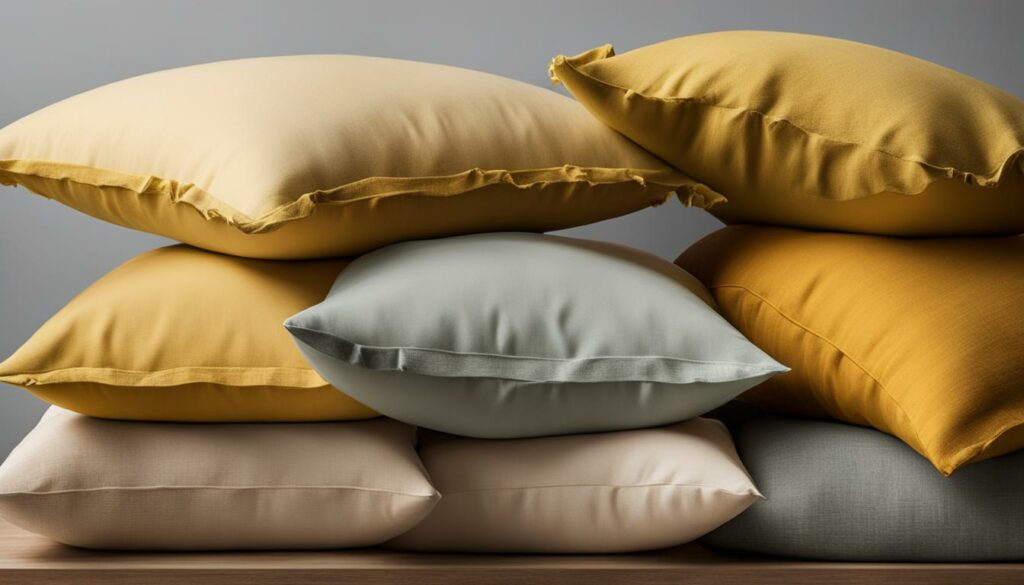
Tips for Maintaining Pillow Hygiene
To ensure optimal sleep quality and hygiene, it is essential to follow proper care and cleaning routines for your pillows. By taking a few simple steps, you can prevent yellow stains and keep your pillows fresh and clean. Here are some useful tips:
- Regularly wash pillowcases: Washing your pillowcases at least once a week can help remove sweat, oils, and dirt that accumulate over time. Cleaning the pillowcases regularly will reduce the risk of yellowing and maintain better pillow hygiene.
- Use pillow protectors: Pillow protectors act as an extra layer of defense against stains, allergens, and dust mites. These protectors should also be washed regularly to maintain cleanliness.
- Replace pillows when necessary: It is recommended to replace pillows every 2 years or as soon as yellow stains start to appear. Over time, pillows accumulate dirt, moisture, and allergens, compromising their hygiene and impacting sleep quality. Regular replacement ensures optimal freshness and comfort.
Your pillows play a vital role in providing a comfortable and healthy sleep environment. Following these pillow hygiene tips will not only help keep your pillows clean but also contribute to better sleep quality and overall well-being.
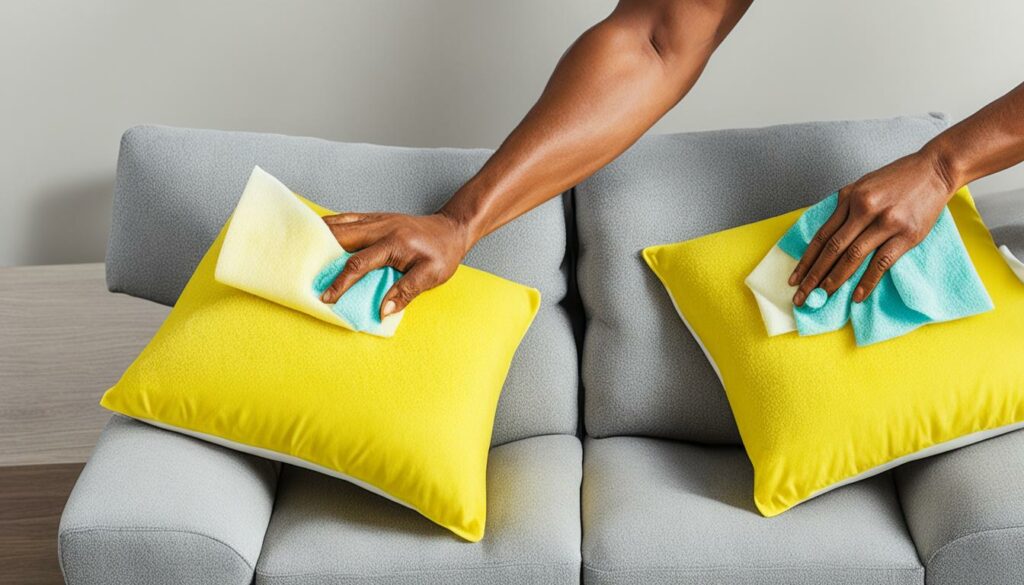
“Proper care and regular cleaning can prevent yellow stains on pillows, ensuring better sleep hygiene.” – Dr. Zubritsky
Solutions for Yellow Stains on Pillows
While it may not be possible to completely remove yellow stains from pillows, there are steps you can take to reduce their appearance. Spot-treating stains with stain removal sprays, creams, or natural remedies like baking soda paste can help minimize discoloration. Following the care instructions provided by the pillow manufacturer is also crucial when attempting to clean pillows. However, prevention is always better than cure, so maintaining proper pillow hygiene and promptly washing pillowcases can help prevent yellow stains in the first place.
Spot-treating Yellow Stains
If you notice unsightly yellow stains on your pillows, don’t worry. You can try spot-treating the stains using the following methods:
- Stain removal sprays: Look for stain removal sprays specifically designed for fabric surfaces. Apply the spray directly to the stained area and let it sit for a few minutes before gently blotting the stain with a clean cloth.
- Stain removal creams: Similar to sprays, stain removal creams can be applied to the stain and left for a few minutes. Afterward, gently rub the product into the fabric and rinse with cold water.
- Natural remedies: A baking soda paste can be an effective natural remedy for removing yellow stains. Mix baking soda with a small amount of water to create a paste, apply it to the stained area, and let it sit for several hours or overnight. Then, rinse with cold water and allow the pillow to air dry.
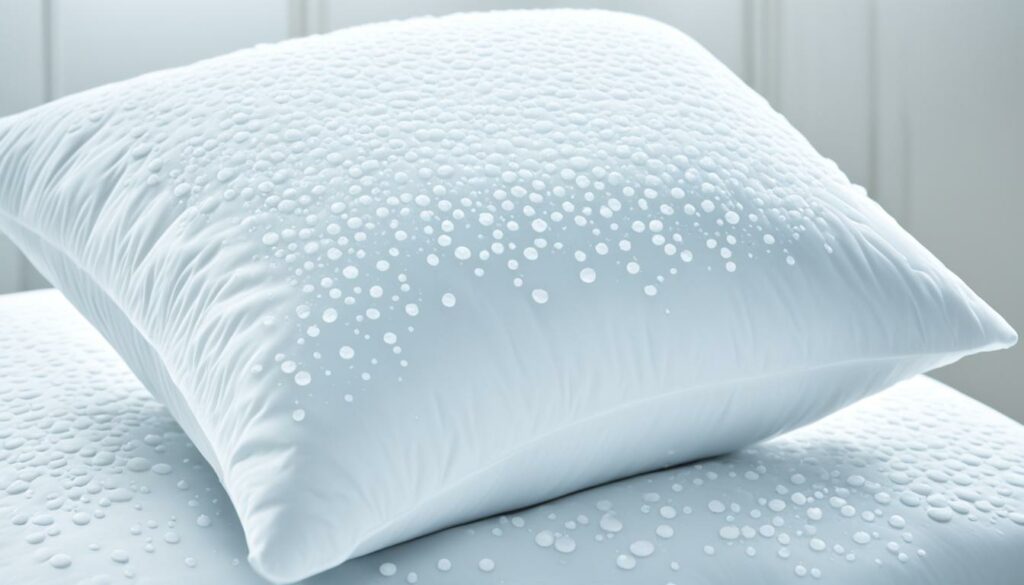
Following Care Instructions
When attempting to clean pillows, it’s essential to follow the care instructions provided by the manufacturer. Different types of pillows require specific cleaning methods to maintain their quality and shape. Some pillows may be machine washable, while others may require spot-cleaning or professional dry cleaning.
To keep your pillows in the best condition possible, refer to the care label or packaging, and follow the recommended instructions. By doing so, you can minimize the risk of damaging the pillow while attempting to remove yellow stains.
Preventing Yellow Stains
Although it’s challenging to completely prevent yellow stains on pillows, maintaining proper pillow hygiene can help reduce their occurrence. Here are some preventive measures to consider:
- Wash pillowcases regularly: Aim to wash your pillowcases at least once a week. This practice helps remove sweat, body oils, and other substances that contribute to yellowing.
- Use pillow protectors: Pillow protectors act as a barrier between your pillow and pillowcase, providing an extra layer of protection against stains. Be sure to wash the protectors regularly as well.
- Rotate and air out pillows: By rotating your pillows regularly and allowing them to air out in a well-ventilated area, you can minimize moisture buildup, which can contribute to yellowing.
While these preventive measures can’t guarantee complete protection against yellow stains, they can significantly reduce the likelihood of discoloration and help keep your pillows in better condition.
Knowing When to Replace Pillows
The frequency of pillow replacement varies depending on the type of filling and how well the pillow is cared for. Generally, it is recommended to replace pillows every 2 years or sooner if they show signs of wear and tear, loss of shape, or yellow staining. Increased allergy symptoms, neck pain, and skin irritations can also indicate the need for a new pillow. Dust mite and mold build-up are common issues in old pillows, which can negatively impact respiratory health. Regularly assessing the condition of your pillows will help ensure better sleep hygiene and overall comfort.
Signs to Replace Pillows
Knowing when to replace your pillows can be crucial for maintaining optimal sleep quality. Here are some signs that indicate it’s time to get new pillows:
- Loss of shape: If your pillow has become flat, lumpy, or no longer provides adequate support, it’s a clear indication that it needs to be replaced.
- Yellow staining: Yellow stains on pillows can be a result of sweat, oils, and dirt accumulation. If regular cleaning fails to remove these stains, it’s a sign that your pillow has reached the end of its lifespan.
- Increased allergies: If you find yourself experiencing more frequent allergy symptoms, such as sneezing, congestion, or itchy eyes, your pillow might be harboring dust mites, allergens, or mold. Replacing it can alleviate these symptoms.
- Neck pain and discomfort: An old pillow that no longer provides proper neck and head support can lead to neck pain, stiffness, and discomfort. Upgrading to a new, supportive pillow can help alleviate these issues.
- Skin irritations: Pillowcases can trap oils, sweat, and bacteria, leading to skin irritations, acne breakouts, or even exacerbating existing skin conditions. If your pillow regularly causes skin issues, it’s time to replace it.
By paying attention to these signs, you can ensure that you replace your pillows at the right time, promoting better sleep, and maintaining optimal sleep hygiene.
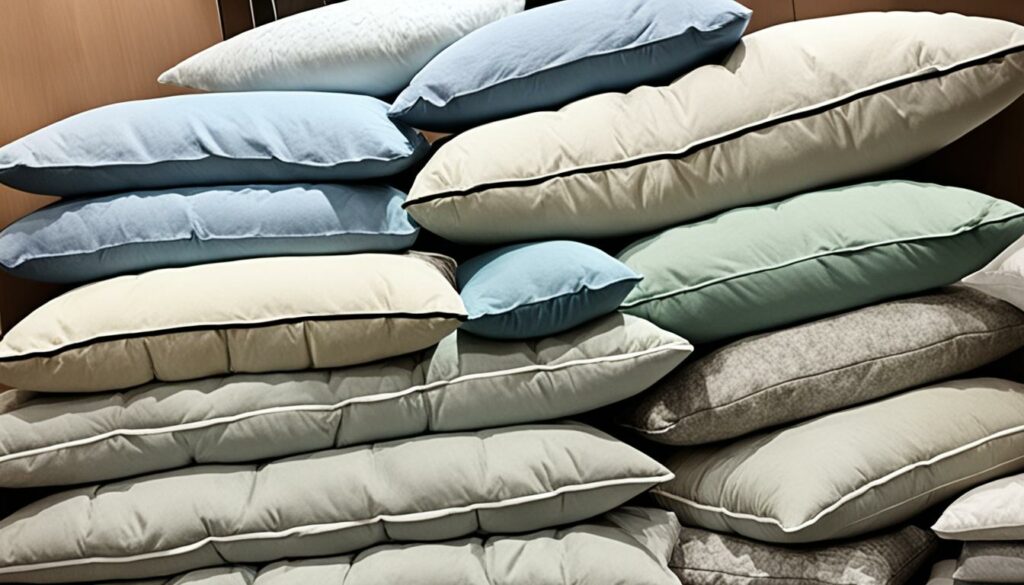
Pillow Care and Maintenance Guidelines
Taking proper care of your pillows is essential for extending their lifespan and ensuring better sleep quality. Follow these guidelines to keep your pillows clean and in good condition:
Use Protective Pillowcases
Protect your pillows from stains, oils, and sweat by using pillowcases. Pillowcases act as a barrier between the pillow and your body, preventing dirt and moisture from penetrating the pillow filling. Choose pillowcases made of breathable and machine-washable materials for easy maintenance.
Wash Pillowcases Weekly
To maintain cleanliness, it is recommended to wash pillowcases weekly. Regular washing helps remove accumulated oils, sweat, and dirt that can cause yellow stains and unpleasant odors on your pillows. Follow the care instructions on the pillowcase label for best results.
Fluff and Air Out Regularly
Regularly fluffing and airing out your pillows helps maintain their shape and prevents clumping. Gently fluff your pillows every morning to redistribute the filling and restore their loftiness. Additionally, allow your pillows to air out by placing them in a well-ventilated area or near an open window for a few hours.
Follow Specific Care Instructions for Different Pillow Fillings
Each pillow filling type has specific care instructions to ensure their longevity:
| Pillow Filling | Care Instructions |
|---|---|
| Polyester Fiberfill | Machine-washable and dryer-safe on a gentle cycle |
| Memory Foam | Spot-clean with mild detergent and air-dry |
| Latex | Spot-clean with mild detergent and air-dry |
| Down and Feather | Dry clean or professionally launder |
| Cotton | Machine-washable and dryer-safe |
| Buckwheat | Empty buckwheat hulls and sun-dry the pillowcase |
Replace Pillows Regularly
Even with proper care, pillows have a limited lifespan. It is recommended to replace pillows every 1-2 years or as soon as they show signs of wear and tear. Yellow stains and lumps in the filling are indications that it’s time for a new pillow. Regularly replacing your pillows ensures optimal hygiene and sleep comfort.
By following these pillow care and maintenance guidelines, you can extend the lifespan of your pillows and enjoy a cleaner and more comfortable sleeping environment. Prioritizing pillow hygiene contributes to better sleep quality and overall well-being.
Different Pillow Types and Replacement Durations
The lifespan of pillows can vary significantly depending on the type of filling material used. To make informed choices and plan for replacements, it’s essential to understand the expected durability of different pillow types.
Polyester Fiberfill Pillows
Pillows filled with polyester fiberfill typically have a shorter lifespan and may need to be replaced every 6 months to 2 years. These pillows offer affordability but may lose their shape and support over time.
Cotton Pillows
Cotton pillows are more durable compared to polyester fiberfill pillows and can last around 2 years with proper care. However, they may also suffer from loss of shape and support over time.
Memory Foam and Latex Pillows
Memory foam and latex pillows are known for their longevity and can last between 2 to 5 years with proper care. These pillows offer excellent support and can retain their shape for an extended period.
Down and Feather Pillows
Down and feather pillows are durable and can last approximately 4 to 5 years. Additionally, these pillows can be refilled to extend their lifespan and maintain their comfort over time.
Buckwheat Pillows
Buckwheat pillows are renowned for their exceptional durability and can last for more than 10 years with appropriate care. The buckwheat hull filling allows for excellent support and breathability, making these pillows a long-lasting investment.
By considering the expected replacement durations of different pillow types, you can choose the most appropriate option for your needs and ensure that you have a comfortable and supportive pillow for a good night’s sleep.
FAQs About Pillow Replacement
When it comes to pillow replacement, you may have some burning questions. Let’s address the most common ones:
1. Is it good to sleep without a pillow?
Sleeping without a pillow can actually provide relief for certain sleepers. It can help align the spine and reduce strain on the neck and back. However, it’s important to note that sleeping without a pillow may not be suitable for everyone. It’s best to consult with your healthcare professional to determine the most suitable sleeping position and pillow choice for your specific needs.
2. How many pillows should I use?
The optimal number of pillows to use is based on individual preferences and sleep positions. Some people find comfort and support with just one pillow, while others prefer using two pillows. Side sleepers often benefit from using a second pillow to support the head and neck, while back or stomach sleepers may find one pillow sufficient. Experiment with different pillow setups to find what works best for you.
3. Which pillows last the longest?
When it comes to durability, buckwheat pillows are among the longest-lasting options. The unique filling of buckwheat hulls allows the pillow to maintain its shape and support for an extended period. Other types of pillows, such as memory foam and latex, can also have a longer lifespan compared to traditional polyester or cotton pillows. Regularly cleaning and maintaining the pillow can help prolong its longevity.
Choosing the right pillow and taking care of its cleanliness and shape are crucial for ensuring a good night’s sleep and overall comfort. Consider your individual needs, sleep position, and personal preferences when selecting a pillow, and don’t forget to replace it as needed to maintain optimal support and hygiene.
FAQ
Are yellow pillows bad?
Yes, sleeping on yellow pillows can have negative effects on your health and skin.
What are the risks of sleeping on yellow pillows?
Yellow stains on pillows can lead to skin problems, respiratory issues, sleep disturbances, and allergies.
What are the benefits of yellow pillows?
While yellow pillows may brighten up the bedroom, the potential risks outweigh their aesthetic appeal.
What are the disadvantages of yellow pillows?
Yellow pillows can accumulate dirt, grime, sweat, and moisture, leading to clogged pores, breakouts, allergies, and asthma.
How do I choose the right pillow color?
Opt for lighter shades like white or beige that allow for easy detection and cleaning of stains and dirt.
What are the benefits of choosing a lighter pillow color?
Lighter pillow colors provide a clean and fresh look and make it easier to spot and clean any discoloration.
How can I maintain good pillow hygiene?
Regularly wash pillowcases, use pillow protectors, and replace pillows every 2 years to ensure cleanliness and prevent yellow stains.
How can I remove yellow stains from pillows?
While complete removal may not be possible, spot-treating stains, following pillow care instructions, and maintaining proper hygiene can help minimize their appearance.
When should I replace my pillows?
It is recommended to replace pillows every 2 years or sooner if they show signs of wear, loss of shape, or yellow staining.
How do I care for and maintain my pillows?
Use pillowcases, regularly wash them, fluff and air out pillows, and follow specific care instructions for different pillow types.
How long do different pillow types last?
The lifespan varies, but polyester pillows may last 6 months to 2 years, cotton pillows around 2 years, memory foam and latex pillows 2-5 years, down and feather pillows 4-5 years, and buckwheat pillows over 10 years.
Can I sleep without a pillow?
Sleeping without a pillow can provide relief for certain sleepers, depending on individual preferences and sleep positions.
How many pillows should I use?
The number of pillows to use depends on individual preferences and sleep positions.
Which pillows last the longest?
Buckwheat pillows are known for their durability and can last for more than 10 years with proper care.
Can I extend the lifespan of my pillows?
Yes, by following proper care and maintenance guidelines, you can prolong the life of your pillows.
Eric Christie stands as a luminary in the bedding industry, with a career spanning nearly four decades since the early 1980s. His journey through the world of bedding has seen him wear many hats – a manufacturer, designer, and retailer, showcasing his versatility and expertise in Read more...


